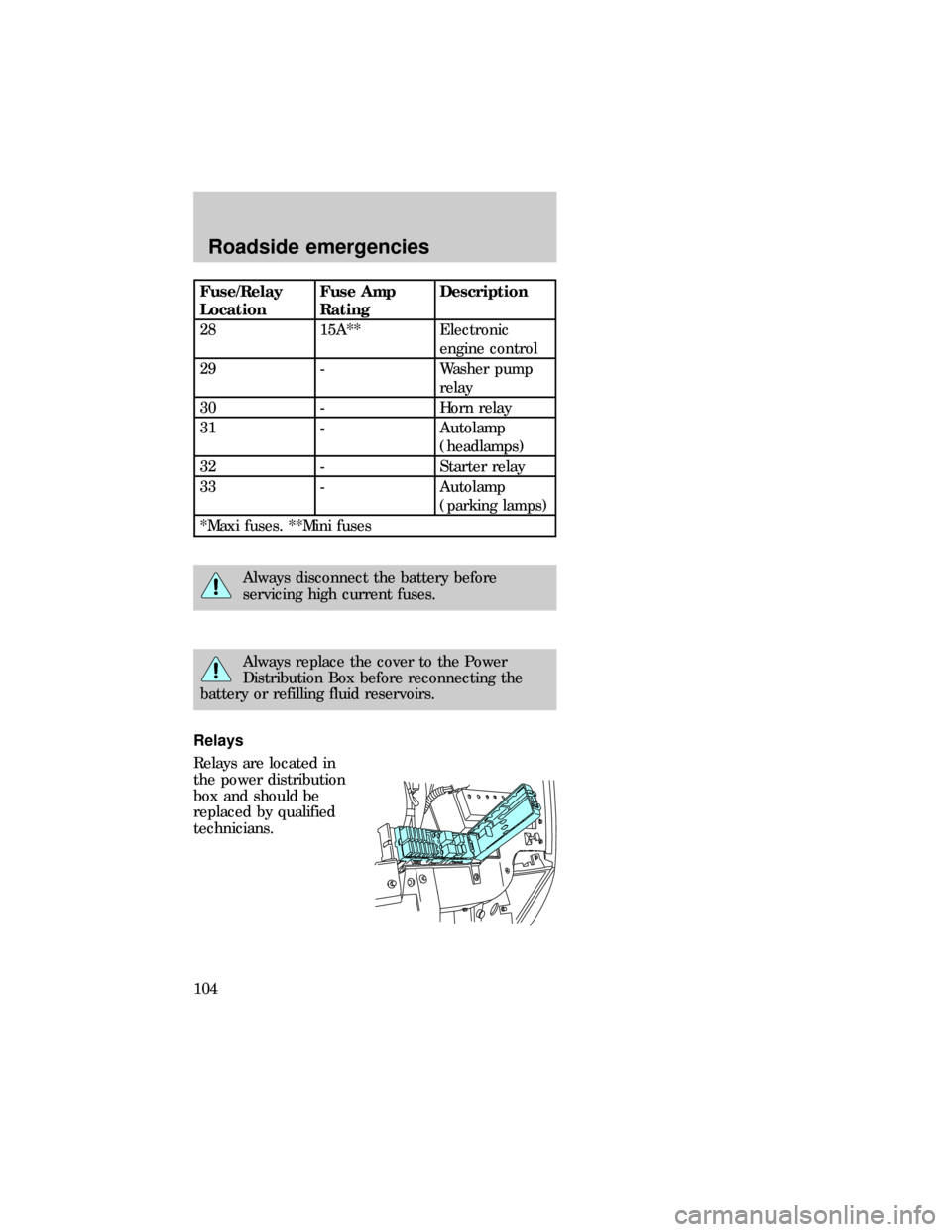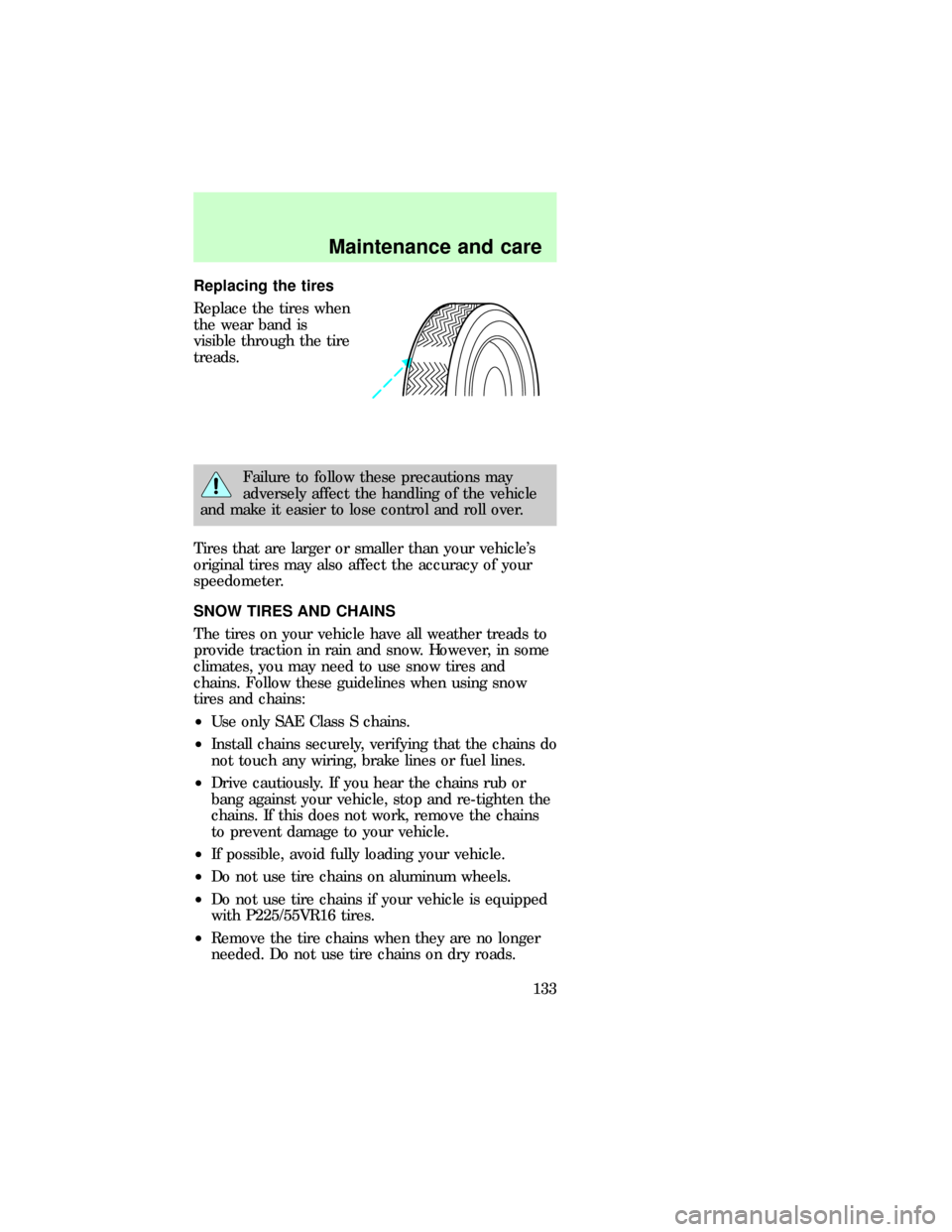tires Mercury Sable 1997 Owner's Manuals
[x] Cancel search | Manufacturer: MERCURY, Model Year: 1997, Model line: Sable, Model: Mercury Sable 1997Pages: 167, PDF Size: 1.59 MB
Page 91 of 167

Do not exceed the GVWR or the GAWR
specified on the Safety Compliance
Certification Label.
Do not use replacement tires with lower weight
capacities than the originals because they may lower
the vehicle's GVWR and GAWR limitations.
Replacement tires with a higher weight limit than
the originals do not increase the GVWR and GAWR
limitations.
TRAILER TOWING
Your vehicle is classified as a light duty towing
vehicle. The amount of weight you can safely tow
depends on the type of engine you have in your
vehicle. Your vehicle does not come from the factory
fully equipped to tow. No towing packages are
available through Ford or Mercury/Lincoln dealers.
Do not tow a trailer until your vehicle has been
driven at least 800 km (500 miles). If towing with a
station wagon, inflate the rear tires to 35 psi.
Towing a trailer places an additional load on your
vehicle's engine, transaxle, brakes, tires and
suspension. Inspect these components carefully after
towing.
The amount of weight that you can tow depends on
the type of engine in your vehicle. See the following
charts:
3.0L 2-Valve Vulcan Engine
Model Passenger
Load #/kg
(lbs.)Luggage
Load kg
(lbs.)Max Trailer
Wt. kg
(lbs.)
Sedan 5/340 (750) 0 365 (800)
4/270 (600) 70 (150) 365 (800)
2/135 (300) 70 (150) 500 (1100)
2/135 (300) 0 565 (1250)
sab_trailer-towing
Driving
91
Page 104 of 167

Fuse/Relay
LocationFuse Amp
RatingDescription
28 15A** Electronic
engine control
29 - Washer pump
relay
30 - Horn relay
31 - Autolamp
(headlamps)
32 - Starter relay
33 - Autolamp
(parking lamps)
*Maxi fuses. **Mini fuses
Always disconnect the battery before
servicing high current fuses.
Always replace the cover to the Power
Distribution Box before reconnecting the
battery or refilling fluid reservoirs.
Relays
Relays are located in
the power distribution
box and should be
replaced by qualified
technicians.
dno_relay
dno_flat-tires
Roadside emergencies
104
Page 105 of 167

CHANGING THE TIRES
Temporary spare tire information
The temporary spare
tire for your vehicle is
labeled as such. It is
smaller than a regular
tire and is designed for
emergency use only.
If you use the temporary spare tire
continuously or do not follow these
precautions, the tire could fail, causing you to lose
control of the vehicle, possibly injuring yourself or
others.
When driving with the temporary spare tireDO
NOT:
²exceed 80 km/h (50 mph) under any
circumstances
²load the vehicle beyond maximum vehicle load
rating listed on the Safety Compliance Label
²tow a trailer
²use tire chains
²drive through an automatic car wash, because of
the vehicle's ground clearance
²try to repair the temporary spare tire or remove it
from its wheel
²use the wheel for any other type of vehicle
dno_spare-tire
dno_change-tire
Roadside emergencies
105
Page 130 of 167

the wiper blades as these will damage the blades.
Changing the wiper blades
When replacing wiper blades assemblies, always use
a Motorcraft part or equivalent. To replace the
blades, follow the instructions on that come with the
new wipers. To make reaching the wipers easy, turn
the ignition to the ACC position, then turn the
wipers on. When the wipers reach the vertical
position, turn the ignition OFF.
INFORMATION ABOUT TIRE QUALITY GRADES
New vehicles are fitted
with tires that have
their Tire Quality
Grade (described
below) molded into the
tire's sidewall. These
Tire Quality Grades are
determined by
standards that the
United States Department of Transportation has set.
Tire Quality Grades apply to new pneumatic tires for
use on passenger cars. They do not apply to deep
tread, winter-type snow tires, space-saver or
temporary use spare tires, tires with nominal rim
diameters of 10 to 12 inches or limited production
tires as defined in Title 49 Code of Federal
Regulations Part 575.104(c)(2).
U.S. Department of Transportation-Tire quality
grades:The U.S. Department of Transportation
requires Ford to give you the following information
about tire grades exactly as the government has
written it.
Treadwear
The treadwear grade is a comparative rating based
on the wear rate of the tire when tested under
controlled conditions on a specified government test
course. For example, a tire grade 150 would weardno_changing-blades
dno_tire-grades
com_about_tire_grades.01
com_treadwear.01
Maintenance and care
130
Page 131 of 167

one and one-half (1 1/2) times as well on the
government course as a tire grade 100. The relative
performance of tires depends upon the actual
conditions of their use, however, and may depart
significantly from the norm due to variations in
driving habits, service practices, and differences in
road characteristics and climate.
Traction A B C
The traction grades, from highest to lowest are A, B,
and C, and they represent the tire's ability to stop
on wet pavement as measured under test surfaces of
asphalt and concrete. A tire marked C may have
poor traction performance. Warning: The traction
grade assigned to this tire is based on braking
(straightahead) traction tests and does not include
cornering (turning) traction.
Temperature A B C
The temperature grades are A (the highest), B, and
C, representing the tire's resistance to the
generation of heat and its ability to dissipate heat
when tested under controlled conditions on a
specified indoor laboratory test wheel. Sustained
high temperature can cause the material of the tire
to degenerate and reduce tire life, and excessive
temperature can lead to sudden tire failure. The
grade C corresponds to a level of performance which
all passenger car tires must meet under the Federal
Motor Vehicle Safety Standard No. 109. Grades B
and A represent higher levels of performance on the
laboratory test wheel than the minimum required by
law.
com_traction_abc.01
com_temperature_abc.01
Maintenance and care
131
Page 132 of 167

The temperature grade for this tire is
established for a tire that is properly inflated
and not overloaded. Excessive speed,
underinflation, or excessive loading, either
separately or in combination, can cause heat
buildup and possible tire failure.
SERVICING YOUR TIRES
Checking the tire pressure
²Use an accurate tire pressure gauge.
²Check the tire pressure when tires are cold, after
the vehicle has been parked for at least one hour
or has been driven less than 5 km (3 miles).
²Adjust tire pressure to recommended
specifications found on the Safety Compliance
Certification Label.
Improperly inflated tires can affect vehicle
handling and can fail suddenly, possibly
resulting in loss of vehicle control.
Tire rotation
Because your vehicle's tires perform different jobs,
they often wear differently. To make sure your tires
wear evenly and last longer, rotate them as indicated
in theService Guide. If you notice that the tires
wear unevenly, have them checked.
com_service.01
dno_checking-tires
dno_rotate-tires
dno_replace-tires
Maintenance and care
132
Page 133 of 167

Replacing the tires
Replace the tires when
the wear band is
visible through the tire
treads.
Failure to follow these precautions may
adversely affect the handling of the vehicle
and make it easier to lose control and roll over.
Tires that are larger or smaller than your vehicle's
original tires may also affect the accuracy of your
speedometer.
SNOW TIRES AND CHAINS
The tires on your vehicle have all weather treads to
provide traction in rain and snow. However, in some
climates, you may need to use snow tires and
chains. Follow these guidelines when using snow
tires and chains:
²Use only SAE Class S chains.
²Install chains securely, verifying that the chains do
not touch any wiring, brake lines or fuel lines.
²Drive cautiously. If you hear the chains rub or
bang against your vehicle, stop and re-tighten the
chains. If this does not work, remove the chains
to prevent damage to your vehicle.
²If possible, avoid fully loading your vehicle.
²Do not use tire chains on aluminum wheels.
²Do not use tire chains if your vehicle is equipped
with P225/55VR16 tires.
²Remove the tire chains when they are no longer
needed. Do not use tire chains on dry roads.
dno_snow-tires-and-chains
Maintenance and care
133
Page 134 of 167

²The suspension insulation and bumpers will help
prevent vehicle damage. Do not remove these
components from your vehicle when using snow
tires and chains.
WHAT YOU SHOULD KNOW ABOUT
AUTOMOTIVE FUELS
Important safety precautions
Do not overfill the fuel tank. The pressure in
an overfilled tank may cause leakage and
lead to fuel spray and fire.
If you do not use the proper fuel cap, the
pressure in the fuel tank can damage the
fuel system or cause it to work improperly in a
collision.
The fuel system may be under pressure. If
the fuel cap is venting vapor or if you hear a
hissing sound, wait until it stops before completely
removing the cap.
Automotive fuels can cause serious injury or
death if misused or mishandled.
Observe the following guidelines when handling
automotive fuel:
dno_fueling
com_important_precautions.06
Maintenance and care
134
Page 165 of 167

arming and disarming
the anti-theft
system ..................... 42
locking/unlocking
doors ................... 41,42
opening the trunk ... 41
panic alarm ............. 42
replacement/additional
transmitters ............. 43
replacing the
batteries .................. 43
Reporting safety
defects ..................... 162
Safety restraints
automatic locking
mode (retractor) 53,54
center rear lap belt 55
extension assembly 58
for children ............. 64
for second row bench
seats ............... 71,72,74
lap and shoulder
belts ......................... 52
maintenance ............ 60
proper use ............... 52
warning light and
chime ....................... 59
Safety seats for children
attaching with tether
straps .................. 69,70
automatic locking
mode (retractor) .... 67
tether anchorage
hardware ................. 70
Seats
adjusting the seat,
manual ..................... 48
adjusting the seat,
power ....................... 49
folding rear seats .... 50
head restraints ........ 48Servicing your
vehicle ...................... 114
precautions when
servicing ................ 114
Spare tire ................. 105
Speed control ............ 22
Speedometer ............. 10
Starting your vehicle 77
preparing to start your
vehicle ..................... 76
starting a warm
engine ...................... 78
Storage
compartments ........... 35
Tachometer
mechanical cluster . 11
Tilt steering wheel .... 27
Tires ......................... 132
changing ................ 106
checking the
pressure ................. 132
replacing ................ 133
rotating .................. 132
snow tires and
chains .................... 133
tire grades ............. 130
treadwear .............. 130
Towing your vehicle 113
Trailer towing ............ 91
tips ........................... 94
Transaxle ................... 83
automatic
operation ...... 84,85,86,
87,88,89
fluid, checking and
adding
(automatic) ... 125,126,
127
Trip odometer ........... 12
Trunk
using the remote entry
system to open ....... 34
Turn signal ................ 25
Index
165